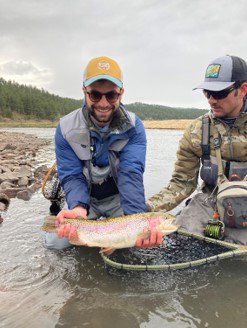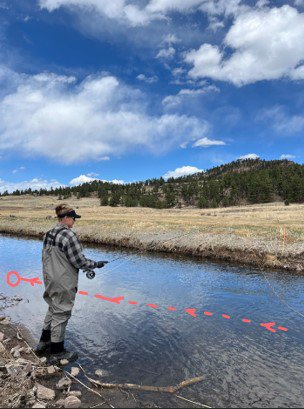Colorado rivers have become a technical nightmare lately, especially for anglers just getting into the sport. Fishing the local waters near Colorado Springs has become a 6x tippet and size 24 midge game at certain times of the year and it very much creates small fly fatigue for more than half of the fishing year. Taking a walk along the South Platte and asking folks what they are using is usually met with the same response, “small, itty bitty midges”.
Now, “the hatch” flies work, and as much as anyone would like to match the hatch, success can be found. However, trout usually take a well-presented meal regardless if it’s the midges that have been hatching most of the year. Even in the summer when caddis are the dominant hatch, you can still fool a trout with a savvy presentation on numerous other patterns.
One of the savvy methods is swinging for trout, which can increase your success on the water as an angler and result in more trout hooked, while partaking in “the waltz” with trout.

“The Waltz”:
The Waltz is the metaphorical dance with the trout that we as anglers partake in, while on the water. As comical it would be to physically waltz with a trout, the waltz is pure imagery for an angler. As Kevin Costner dances with wolves, we dance with trout. The motivation to meet trout with a fly rod is as beautiful a comparison to meeting a wolf on the plains.
This waltz leads us as anglers into the most beautiful landscapes that can be found in the west, and allows us to be one with nature, with water flowing between our feet and the roaring sounds of the river soothing our nerves from the week’s built-up stress. It is in this moment we find ourselves in the waltz, and dancing to the tune of the trout on their terms.

“The Swing”
The swing is a literal term to describe how the angler drifts their flies to trout in his dance with trout. It is not very difficult to achieve either. If you have two left feet while dancing, the trout swing will fare much better for you as an angler because it requires a swing of only the fly line as it drifts away.
The swing essentially purports action onto the flies after a natural drift. This means that the beginning and middle parts of your drift can be fished normally, just as any angler has been taught to fish a nymph: “drag free”. The difference is in on the last third of the drift, when the indicator begins moving further downstream of you. Instead of throwing a final mend in, let the current swing the flies around and drag the indicator as far as possible until the line straightens out downstream.
The figure below, contains a visual image of when you may begin to swing your flies. The dotted line represents the natural portion of the drift, and the solid line represents the swing. The arrows indicate current direction. The circle indicates the usual strike zone of a swing, and where I catch most fish on the swing.

I have found that swinging flies is highly effective when fishing a riffle, run, pool, and tailout. Throwing your flies into the run at the top and drifting them naturally through the pool allows your flies to get down deep and hopefully pick up a big fish sitting at the bottom of the pool. The current from the run will progress your drift through the pool and ultimately push your flies into the tailout. At this point, the swing has begun. Your flies will begin to rise and dance along as the drag from the swing creates lift on the flies. This often makes it look like the flies are dancing, or moving towards the surface of the water to hatch. The action that is created by the swing can illicit some pretty impressive reaction strikes from fish that would normally avoid the flies. The action from the swing is so enticing to fish and can be a go-to method when natural drifts are not getting attention.
When it comes to fly selection, patterns that create movement in the water tend to be the most effective. Seeing baetis caught in current leads me to believe they are so effective on the swing because they have very noticeable lateral thorax movements while trying to swim up to the surface. Baetis, pmd’s, caddis, stonefly, leech, worm, and scud patterns are good examples. When these bugs are in the nymphal stage, they naturally move and the swing effectively imitates that movement.
Conclusion:
So, what are you waiting for? Get out on the water and try a swing the next time you are partaking in the waltz for trout. You may just surprise yourself by landing some impressive fish like my client in the above picture, who landed a beautiful rainbow on a swung Juju Baetis. Like Wayne Gretzky once said, “you miss 100% of the shots you don’t take”, so if you want to hook trout on the swing, experiment and practice, just like you would with any other skill. Furthemore, don’t get discouraged as new techniques take some time to nail down. This technique is worth it in my professional opinion, as it helps me increase the number of trout pulled to the net.
